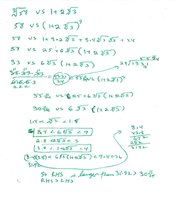\(\displaystyle A = \ \sqrt[3]{58} \ \ \ and \ \ \ B = \ 1 + 2\sqrt[3]{3}\)
Without using a calculator or computer, show which is greater, A or B.
Here's how I would do it:
\(\displaystyle A = \sqrt[3]{58} = 58^{\frac{1}{3}} \implies \ln(A) = \frac{1}{3} \cdot \ln(58)\)
\(\displaystyle B - 1 = 2\sqrt[3]{3} = 2 \cdot 3^{\frac{1}{3}} \implies \ln(B - 1) = \ln(2) + \frac{1}{3} \cdot \ln(3)\)
\(\displaystyle A - (B - 1) = \frac{1}{3} \cdot \ln(58) - \frac{1}{3} \cdot \ln(3) - \ln(2) = \frac{1}{3} \cdot \left[\ln(58) - \ln(3) \right] - \ln(2) = \frac{1}{3} \cdot \ln \left( \frac{58}{3} \right) - \ln(2)\)
\(\displaystyle A - B = \frac{1}{3} \cdot \ln \left( \frac{58}{3} \right) - 1 - \ln(2) = \frac{1}{3} \cdot \ln \left( \frac{58}{3} \right) - \ln(2e)\)
Now I'll use some crude approximations and known facts to bound these numbers.
\(\displaystyle (e > 2) \wedge (2 > 1) \implies e < 2e < e^2 \implies 1 < \ln(2e) < 2 \implies 3 < \ln(2e) < 6\)
\(\displaystyle e \approx 2.7 \implies e^3 \approx 2.7^3 = 19.683\)
\(\displaystyle \frac{58}{3} = 19.\overline{33} \implies \frac{58}{3} < e^3\)
The natural log function is monotonically increasing for \(x > 0\) (if desired this can be a calculator-free subproof involving the derivative) so that means:
\(\displaystyle \frac{58}{3} < e^3 \implies \ln \left( \frac{58}{3} \right) < \ln(e^3) \implies \ln \left( \frac{58}{3} \right) < 3\)
From this I can conclude that:
\(\displaystyle \ln \left( \frac{58}{3} \right) < 3\ln(2e) \implies \frac{1}{3} \cdot \ln \left( \frac{58}{3} \right) < \ln(2e)\)
Both \(\frac{58}{3}\) and \(2e\) are greater than 1, so their natural logs must be positive. Putting everything together, we have:
\(\displaystyle A - B = (\text{A positive number}) - (\text{A bigger positive number}) < 0\)
And thus, \(B\) must be the bigger of the two numbers.

